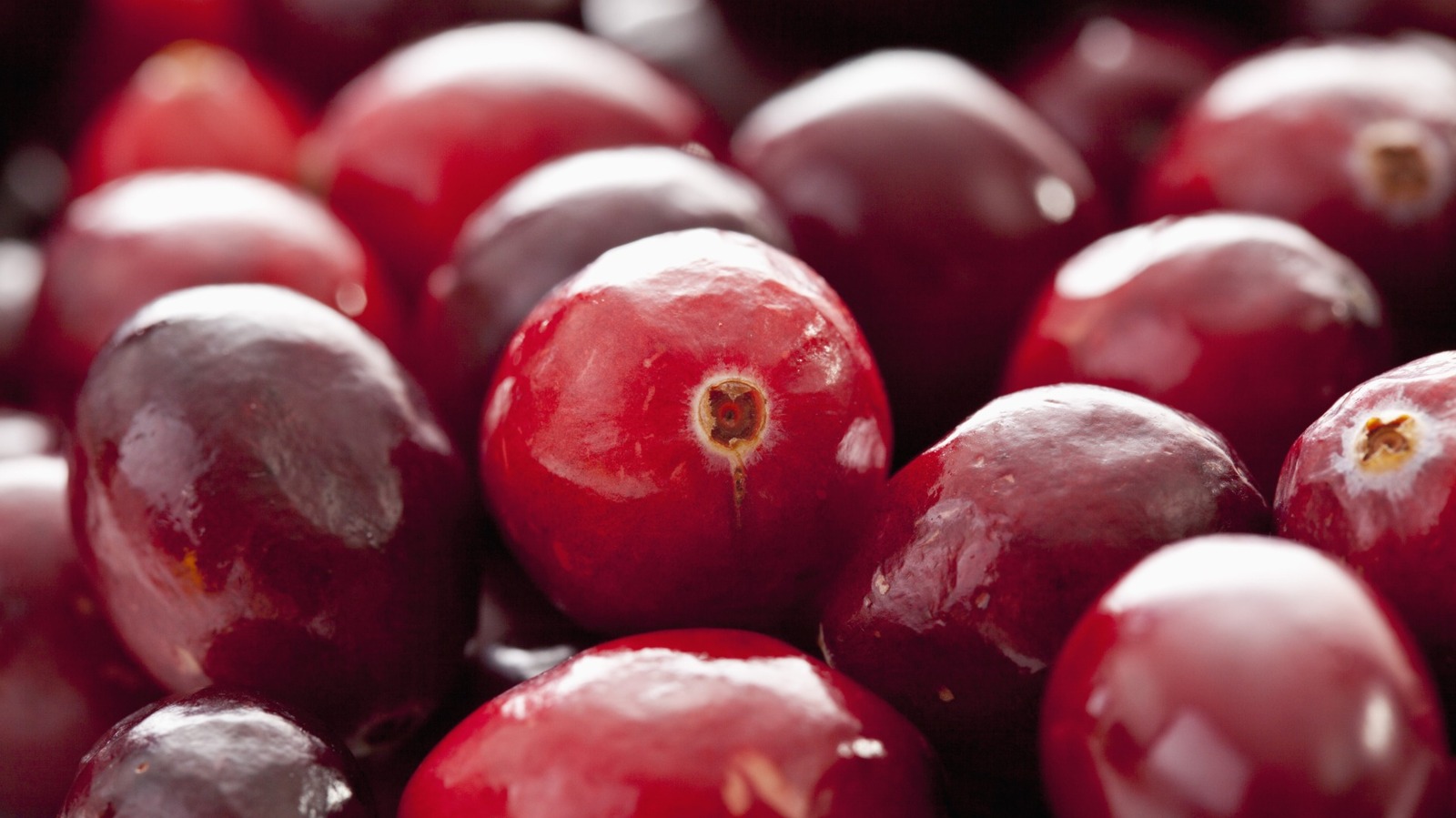
When it comes to tart, red fruits, most of us are familiar with cranberries, as they frequently make an appearance on the dinner table during Thanksgiving. That said, there is another, equally delicious, crimson-hued fruit with a bite, that is often mistaken for the cranberries — lingonberries. These jewel-like berries share a lot in common with cranberries, such as growing on evergreen plants found in the crisp regions of the Northern Hemisphere.
That said, for all of their similarities, they are quite distinct from one another. From their size and where they can typically be found to their taste and how they are incorporated into recipes, cranberries and lingonberries each have their own unique characteristics that make them valuable in different ways. They also feature prominently in the cultural traditions of different countries, like the United States and Sweden.
As a chef, I am always searching for ways to incorporate nuance into my recipes. Exploring the traits of similar ingredients integral to different cuisines, and learning to exploit these in various dishes, is a guaranteed way to create complexity in my cooking. When it comes to adding a pop of color and a burst of sweet-yet-sour flavor to a dish, cranberries and lingonberries are the way to go.
Here's some of the differences and similarities between these fruits. What are cranberries? Cranberries are a clever ingredient that features in many recipes beyond the jellied sauce we all grew up with at the Thanksgiving table. But what exactly are they? While there are many different types of cranberries, all of these are members of the Vaccinium genus of plants.
These evergreen vines and dwarf shrubs are native to cooler northern climates. The two most common subgenera of cranberries are the wild Oxycoccus, which is found in Northern Europe, and the cultivated Macrocarpon, which is grown in North America (including the U.S.
and Canada). Though they contain the moniker "berries" in their name, these fruits don't actually fit the definition of a true berry. They are a member of a group of fruits known as "false" or "epigynous" berries.
These fruits don't emerge from the ovary of the plant, but rather from other parts of the plant, outside of the flower. Cranberries are pollinated by honey bees, many of which were brought to America by early settlers to aid in cultivation. Though wild cranberries have been enjoyed by indigenous populations for centuries, they were not cultivated until the 1800s.
Contrary to popular belief, cranberries do not grow in water. They are cultivated in sandy soil, then wet or dry harvested from September to October (which explains their popularity in autumnal culinary traditions). Wet harvested fruit, which is sourced from bogs that have been flooded, is predominantly used for juice and sauce, while dry harvested fruit is often sold fresh.
What are lingonberries? If you have ever eaten Swedish Fish and wondered what exactly their flavor is , you are already familiar with lingonberries. Lingonberries, or cowberries, are also members of the Vaccinium family of plants, more specifically the Vitis-idaea sub genera. These cousins of the cranberry grow on low-lying evergreen shrubs that are native to the Northern Hemisphere, predominantly boreal forests found in the Arctic tundra across Europe, Asia, and parts of North America.
Lingonberries are also "false berries," though they are self-pollinating (meaning their flowers have both male and female reproductive parts). Though lingonberries have been cultivated, for the most part, they continue to grow in the wild, where they are routinely foraged in the late summer months, particularly during August and September, when they are at their ripest. Lingonberries have long been coveted for their lengthy shelf-life, and many purported culinary and medicinal purposes.
While they may be most frequently associated with Scandinavian culinary traditions, particularly those from Sweden, cultures across Northern Europe have long revered the lingonberry. Lingonberries are frequently the focus of folk tales and heralded for their life-giving properties, which stems from their capacity to grow in areas that are typically inhospitable to other edible plants. They grow in different regions Though wild lingonberries and cranberries can be found across the Northern Hemisphere, the former are more typically associated with Northern Europe and parts of Asia, while the latter is generally seen as a North American staple.
As previously noted, though lingonberries have been cultivated, they are only farmed in limited quantities, predominantly in the Pacific Northwest of the U.S. and parts of Northern Europe, from the Netherlands and Germany to Russia and, you guessed it, Sweden.
Additionally, they thrive in much colder climates, making them more of a niche plant that is less widespread, but better capable of enduring temperatures that would not favor cranberry production. By contrast, cranberries are widely cultivated, thriving in moist, acidic soils in regions that are cool, but not cold. According to The Cranberry Institute , there are now approximately 58,000 acres of cranberries cultivated across North America and in parts of Chile.
The Animal Agriculture Alliance notes that the U.S. leads world cranberry production, with nearly 75% of the global supply hailing from there, while Wisconsin is the most prolific state in the country, providing three-fifths of the American supply annually.
For reference, approximately 20% of the cranberries grown annually are consumed at Thanksgiving. A vast majority of the fruit that is cultivated, approximately 95%, is transformed into juice, jam, jelly, or dehydrated. A single pound of cranberries contains roughly 440 pieces of fruit, while one gallon of juice requires approximately 4,400 berries.
Cranberries are typically larger than lingonberries The morphology of the cranberry and lingonberry also differ in notable ways, most particularly in size. Cranberries are the larger of the two, growing to roughly 1.5 to 3 centimeters in diameter.
Lingonberries, by contrast, typically max out at between 6 and 10 millimeters in diameter. Additionally, cranberries are round in shape, while lingonberries can vary from circular to oval. The skin of the cranberry is firm and shiny, and can range in color from white to red.
Contrary to popular belief, white cranberries are not a different fruit. They are simply berries that have been harvested early in the season, or ones that were not exposed to sunlight. As cranberries ripen, they spend more time in the sun and in colder temperatures, factors which draw out the red color.
When white cranberries are either frozen or cooked, they will turn red. Lingonberries are known for their especially hardy skins, which make them so resistant to cold temperatures. They can range in color from lighter red to deep maroon, depending on the plant, where it grew, and when the berries were harvested.
Lastly, cranberries have a porous interior, giving them a buoyant quality that has earned them the moniker "bounce berries." The flesh of lingonberries is punctuated by tiny seeds and they have a tender, juicy quality that makes them somewhat less springy. Lingonberries are sweeter than cranberries As with all fruits, both cranberries and lingonberries will vary in taste depending on when they are harvested.
The longer these fruits are allowed to ripen, the more concentrated their sugar content becomes, which equals sweeter fruit. That said, when picked at peak ripeness, lingonberries are less acidic and do tend to have a slightly sweeter flavor profile than their larger, bouncy cousins. Despite this, both of these fruits are characterized by their distinct tartness, which can make your mouth pucker when you bite into them.
Additionally, neither cranberries nor lingonberries are climacteric fruits. This is a term that refers to fruits that can ripen after picking them . Some fruits, like bananas and avocados, can be harvested when green and will ripen because they are autocatalytic, meaning the amount of ethylene, the gas responsible for jumpstarting the ripening process, will increase the moment they are picked.
For this reason, you will want to avoid consuming green cranberries and lingonberries. Their taste will be far too sour to enjoy, even if they are cooked or dehydrated. They have different levels of nutrients Cranberries and lingonberries in their raw state are both low-calorie, high-fiber food sources.
They are also nutritional powerhouses when it comes to vitamins and minerals. This is why native cultures have long relied on them for sustenance and medicinal purposes. That said, each berry excels in different areas, and, though they can be consumed raw, they are frequently processed to help minimize their tartness, which will impact their potential health benefits.
Cranberries are a rich source of vitamins C, E, K1, manganese, and copper. They are also loaded with dietary fiber, which can benefit digestive health and help to regulate blood sugar levels. Additionally, cranberries are loaded with antioxidants, including the polyphenols quercetin, myricetin, and A-type proanthocyanidins, which are the compounds most commonly associated with their purported abilities to help maintain good urinary tract health.
Lingonberries are also considered to be something of a superfruit. They too are rich in dietary fiber and vitamins C, E, and manganese. But, what they are most well-known for is their high concentrations of antioxidants and flavonoids, particularly anthocyanins and quercetin.
These compounds have been linked with a host of health benefits, from reducing inflammation to promoting good eye health to minimizing the risk of cancer. They are usually prepared differently Though lingonberries and cranberries are often used interchangeably, they do differ in how they are typically prepared. While both are safe to consume raw, cranberries are seldom eaten this way, as they tend to be too tart for most palates.
Lingonberries, by contrast, are occasionally consumed raw. One classic Swedish recipe, known as Rårörda lingon, combines raw lingonberries with sugar until they become macerated, creating a type of uncooked preserve that is delightful served on toast or atop breakfast cereal. Another difference between these two fruits is that, while they both can be used for sweet and savory recipes, cranberries are more often associated with the former, while lingonberries frequently star in the latter.
When it comes to cranberries, certainly juice and jellied sauce come to mind. Their sweet and tart notes pair beautifully with bright flavors and a healthy amount of acidity. A more unusual application for this fruit involves turning it into a salad dressing for a festive fall combination paired with blue cheese, canned pears, dried cranberries, and chopped walnuts.
If the first thing that comes to mind when you think of lingonberries is the meatballs at IKEA, you wouldn't be alone. They are the star ingredient in the famous Swedish meatballs, which can be elevated in an instant by adding just one extra ingredient — fennel seeds. Lingonberries are also commonly transformed into a sauce that beautifully complements wild game, a common type of meat consumed in Scandinavian countries.
Lingonberries are harder to find While cranberries are widely available in the U.S. in many forms, from fresh and dried fruit to juice and jellied sauce, lingonberries are not.
In fact, they are one of those foods that you might only find in Sweden or other countries across Northern Europe and Asia. Indeed, because they are seldom cultivated and wild berries only grow in such a selective climate, lingonberries are scarcely sold commercially. If you are on the prowl for these superfruits, you may want to hop on the internet, where lingonberries can be obtained in many forms, including fresh, frozen, and juices.
They can also be found dried, like these ones from LOOV , and processed into jam or jelly, such as the one available from Felix . While fresh cranberries have a shelf-life of just about a week, lingonberries are far more durable, lasting between three and five weeks, depending upon the packaging. Both fruits can be easily frozen for longer storage, though they will need to be cooked for the best texture.
.














